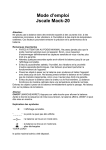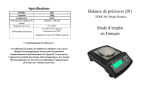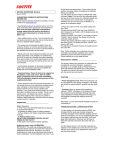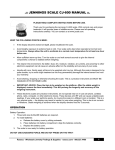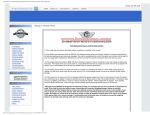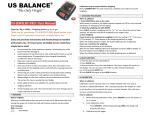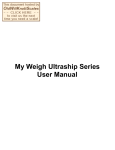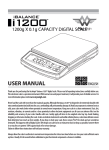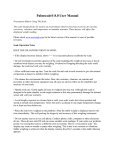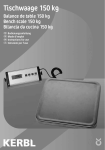Transcript
KEY PAD FUNCTIONS * UNIT Unit (mode) selection: Press and release the key once to change weight unit You can select g (grams), oz (ounces), dwt (pennyweight), ozt (troy ounces), ct (carats), gn (grains) or lb(pounds/mg(miligrams) * PCS (Count) Sample sizes can be 25, 50, 75 or 100 The following steps outline the procedure for cummulative weighing of samples: Switch the scale on, Place a 'given' number of samples of an item on the tray. Press the [UNIT] key several times to put the scale in PCS mode (the indicator should be on pcs). Select the sample size (the same as you chose above) by pressing the [PCS] key (press it as many times as necessary to put it in the correct sample size (the sample size is the same as in step three =10,20,50or 100), Press the [UNIT] key, the display will show "pass", then after 2 seconds, the scale will remember the sample size you selected and show the starting sample size on the display.(You can now remove the samples if you want to return the scale to 0pcs). Place the items that you want counted onto the tray, the total number of items will show on the display.Press the [UNIT] key to exit the counting function and return to normal weighing mode * È ON/OFF Press this key to turn unit on. Once the unit is on, press and hold the same key to turn the scale off * ZERO (TARE) Press Zero to reset the scale to zero. This can be used for eliminating from a sample (or a Tray/Container) the weight value of a container weight is permanently removed for the remainder of the procedure. Just turn the scale ON, place the tray or container on weighing platform, and press the ZERO key. The scale will show 0.0 (or 0.00) on the display and you can add items to the container/tray. NOTE: When all weight are removed from the weighing tray, the tared value of a container will be displayed as a negative number. Cycle the power on the scale to reset the scale to zero. * LIGHT Press the center [Light] key to turn on the bright LCD backlight. It will stay on for several seconds. Press this key again to turn off the backlight. Selection of auto-power-off mode Press and hold [UNIT] , then press [ON/OFF], The scale will enter the function setting mode. The display will show A_ON or A_OFF, Press [ZERO] , the display will show A_ON, this means auto- off function active. Press [ZERO] again, the display will show A_OFF, (auto-off function inactive). ** These electronic scale are precision instruments. Avoid disturbing environmental conditions such as currents, vibrations, strong electrical and magnetic fields as well as a rapid change of the ambient temperature. OPERATION_____________________________________________ Battery Operation: 1) Three “AAA” size ALKALINE batteries are required. 2) To install batteries: a) Release the battery cover by sliding out-wards. b) Place batteries into battery compartment aligned correctly. c) Replace battery cover. DO NOT USE EXCESSIVE FORCE & DO NOT PRESS ON THE TRAY!!! 3) The scale is now ready for battery operation. (Advanced users only) CALIBRATION______________________________ IMPORTANT: This scale was professionally factory calibrated before shipment and does NOT need to be recalibrated by the end user. However, if you wish to recalibrate your scale we provide these instructions for calibration: Repeat calibration if the display locks on 8888, EEEE or LLLL. Incorrect calibration can occur if you do not follow the steps exactly. If your scale does not perform accurately, please try replacing your batteries before you calibrate. You will need a calibration weight (see below) to calibrate this scale. NOTE: if you do not have access to a calibration weight you can purchase one at your local store or in emergency situations you can use coins or weights (ie 20 US Nickels = 100g) as a calibration weight. The JS-200XV and 100XV require a 100 gram weight to calibrate Before Calibration please turn the scale on and let it warm up for 2 minutes. 1) Place the scale on a Flat, very stable surface and turn it OFF 2) Press and hold the “UNIT” key (don’t release it), then press and release ON/OFF. The display will show the AD value (a random series of numbers), now you can release the UNIT key. 3) Press the UNIT key again, the display will flash 0SAVE and then 100.0 (the AD value may show for a moment in between) 4) Gently place 100g on the tray and then press the UNIT key. The display will show 0SAVE and return to the AD value. 5) Calibration is complete, Remove the weight and turn the scale Off. NOTE: if after calibration your scale does not read accurately, this indicates calibration error and the calibration process should be repeated slower. Please calibrate on a very stable flat surface INACCURACY / ERROR___________________________________ The primary reasons for inaccuracy or malfunction are low batteries, incorrect calibration, overload or operating on an unstable surface. Please keep this in mind and maintain and operate your scale properly. The scale is a precise instrument and must be handled with the upmost care and caution. JSCALE JS100/200XV MANUAL PLEASE READ COMPLETE INSTRUCTIONS BEFORE USE Thank you for purchasing The Jennings JS-XV. With normal care and proper treatment it will provide years of reliable service. Please read all operating instructions carefully. You can contact us at www.Jscale.com .KEEP THE FOLLOWING POINTS IN MIND: * Avoid lengthy exposure to extreme heat or cold, your scale works best when operated at normal room temperature. If the scale has been subjected to temperature change, please allow the scale to acclimate to normal room temperature for at least one hour before use. * Allow sufficient warm up time. Turn the scale On and wait several seconds to give the internal components a chance to stabilize before weighing. * The cleaner the environment the better. Dust, dirt, moisture, vibration, air currents and proximity to other electronic equipment can all cause an adverse effect on the reliability and accuracy of your scale. * Handle with care. Gently apply all items to be weighed onto tray top. Although this scale is designed to be quite durable, try to avoid rough treatment as this may permanently damage the internal sensor and void your warranty. * Avoid shaking, dropping or otherwise shocking the scale. This is a precision instrument and MUST BE HANDLED WITH EXTREME CARE. *IMPORTANT ADVICE: Place the item to be weighed on the platform, after the stable weight is displayed remove the item immediately. This will prolong the longevity and accuracy of this weighing instrument. .** These electronic scale are precision instruments. Do not operate near an inuse cell phone, cordless phone, radio, computer or other electronic device. These devices emit RF and can cause unstable scale readings. If your scale ever performs poorly, try moving the scale to a different room or location. This is a very precise scale - the display may seem to wander or jump when weighing. This is due to air currents or vibrations. Stable weighing is achieved when the display remains fixed for 3 seconds. FEATURE_______________________________________________ * Power Up Segment Test: When first turning the unit on, all segments of the display will appear as shown below. This display will remain for approximately 2 seconds and then reset to 0. HELLO * Overload: When an applied load exceeds the capacity. “EEEE” will appear on the display. Remove the excessive load immediately! Although the JS uses proprietary overload protection technology, it is still possible to damage the weighing sensors by overload. !Remember: You can permanently damage the scale by overloading it! * Weighmeter™: On the side of the display you will notice a series of bars that increase as the load on the scale increases. This is our Weighmeter™ invention. It helps you know the remaining capacity on the scale and also will indicate an overload if one occurs. Please use the Weighmeter™ to monitor your weighing loads and please do not overload this scale. TROUBLESHOOTING & OPERATION NOTES: 1) If the Display ever becomes locked on 8888, LLLL or EEEE, this indicates that the scale was shocked, dropped or otherwise damaged and the delicate weighing sensors may have been damaged. Please try recalibrating the scale (If the sensor has not been hurt too badly it will work again after recalibration). Otherwise you will have to follow the warranty instructions that came with your scale. 2) If the display becomes locked on –LO--, this often indicates low batteries. However sometimes it also may indicate a serious zero mark error. This means when you turn the scale on, it can't determine what zero is (a slight zero mark error will cause situation #1 above) Thus, if new batteries do not fix this error the scale will have to be sent to us for replacement under our 5 year warranty program. Although the JSV is designed to be extremely durable, It’s important that you never overload or drop/shock the scale. Scales are delicate instruments and unlike Cellular phones, scales have delicate sensors that determine how much an item weighs. If you drop or shock your scale, these sensors "feel" the shock and are sometimes destroyed. This happens with all digital scales. We design our scales to be as resistant to shock or drops as possible, however there is no way for us to protect 100% against load cell or sensor damage. A well-treated scale will provide years of reliable and accurate weighing. However an abused scale will only work until it’s sensors are damaged.

